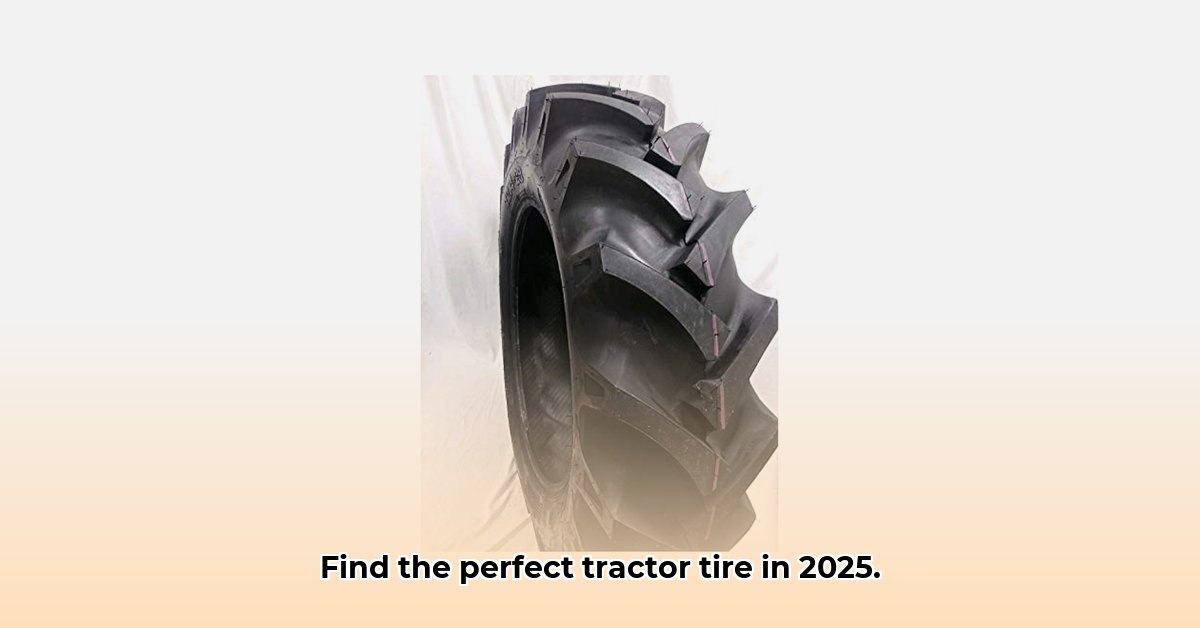
Choosing the Right 13.6 x 24 Tractor Tires for Your Farm
Selecting the optimal 13.6 x 24 tractor tires significantly impacts farm efficiency, operating costs, and soil health. This comprehensive guide helps you navigate the selection process, focusing on performance, longevity, and sustainability. We'll explore key features, maintenance strategies, and responsible disposal methods to maximize your investment. For more tire size options, see our guide on other tractor tire sizes.
Matching Tires to Your Farming Operation
Before examining specific tire brands, understanding your individual farming needs is paramount. Consider these factors:
Terrain: Do you primarily operate on flat fields or challenging, hilly terrain? The tire's tread pattern and construction will need to match the soil conditions. Deep treads excel in muddy fields, while shallower treads are better suited for hard-packed soil.
Soil Type: Heavier clay soils require tires with superior traction to minimize slippage and prevent compaction, while lighter, sandy soils may allow for more flexibility in tire choice.
Equipment: The weight of the equipment towed dictates the required load capacity of the tires. A heavy harrow demands tires with higher load ratings than a lighter seeder. Overloading tires dramatically shortens their lifespan.
Fuel Efficiency: Some tire designs minimize rolling resistance, resulting in fuel savings over time. This indirect cost saving should be considered alongside the initial tire purchase price.
Addressing these questions will determine which tire features are most crucial for your farm.
Top 13.6 x 24 Tractor Tire Brands: A Comparative Analysis
Several reputable brands manufacture 13.6 x 24 tractor tires. The following table offers a preliminary comparison, recognizing that real-world performance varies based on individual usage and soil conditions. Further research, including independent testing and user reviews, is strongly advised before making a purchase.
| Tire Brand | Overall Rating (Preliminary) | Pros | Cons |
|---|---|---|---|
| Firestone Super All Traction II | Excellent | Outstanding traction, long lifespan | Higher initial cost |
| Galaxy Earthpro | Good | Budget-friendly, acceptable performance | Shorter lifespan than premium tires |
| BKT TR-135 | Data Insufficient | ||
| Alliance Farmpro 324 | Data Insufficient | ||
| Petlas TA60 | Data Insufficient | ||
| Titan Hi Traction Lug | Data Insufficient |
Note: The ratings above are based on currently available data. Comprehensive testing and user feedback are essential for a complete evaluation.
Key Tire Features for Optimal Performance
Understanding the key features that influence tire performance is critical.
Tread Depth and Pattern: Deeper treads offer superior grip in wet or muddy conditions, although shallower treads might be preferable on hard-packed soil or paved surfaces. The tread pattern's design impacts traction on various soil types.
Load Capacity: The tire's load rating must exceed the combined weight of the tractor and any attached implements to avoid premature wear and potential damage. Always consult your tractor's manual.
Tire Construction: Robust tire construction, including reinforced sidewalls, enhances durability and puncture resistance, ultimately extending the tire's useful life.
UTQG Rating (Uniform Tire Quality Grading): While availability for 13.6 x 24 tires may be limited, the UTQG rating, where available, provides valuable insights into treadwear, traction, and temperature resistance. A higher rating generally reflects superior performance and longevity.
Environmental Impact: Sustainable practices are paramount. Consider the tire's life cycle, from material sourcing to disposal, selecting brands committed to responsible practices and recycling programs.
Maintaining Your Investment: Tire Care and Management
Proper tire maintenance maximizes lifespan and minimizes operational costs.
Inflation: Maintain the manufacturer's recommended tire pressure. Incorrect inflation drastically reduces tire lifespan and negatively impacts fuel economy. Regularly inspect for leaks or damage.
Driving Practices: Avoid aggressive driving maneuvers, such as sharp turns or sudden braking, which induce unnecessary stress and accelerate tire wear.
Storage: When tires aren't in use, store them in a cool, dry location, protected from sunlight and extreme temperatures.
Rotation: Periodic tire rotation ensures even wear, significantly extending their lifespan.
Sustainable Tire Choices for Reduced Soil Compaction
Soil compaction reduces water infiltration, oxygen flow, and root growth, negatively impacting crop yields. Tire selection plays a significant role in mitigating compaction.
Soil Assessment: Clay soils are more susceptible to compaction than sandy soils. Choose tires with larger footprints to minimize pressure on clay soils.
Farming Practices: No-till farming necessitates tires designed to minimize soil disturbance.
Operational Needs: The tractor's primary use (plowing, planting, harvesting) influences the required traction and durability.
Tire Specifications: Examine tread depth, ply rating, and construction. Deep treads offer greater traction but may increase soil disturbance if not properly inflated.
Innovative Designs: Explore tires with wider footprints or advanced tread patterns designed to reduce ground pressure.
Inflation Management: Proper inflation is crucial. Underinflation increases compaction; overinflation reduces traction and damages soil structure.
Disposal Planning: Choose tires and disposal methods that prioritize environmental sustainability.
Choosing the Right 13.6-24 Tires: A Summary
Selecting appropriate 13.6 x 24 tractor tires is a crucial decision impacting your farm's efficiency and sustainability. This guide offers a starting point for your research. Consult with local agricultural suppliers and experienced farmers for valuable insights tailored to your specific conditions and needs. Consider small-scale trials to assess various tire performanmce. Thorough research and informed decision-making will serve you well.